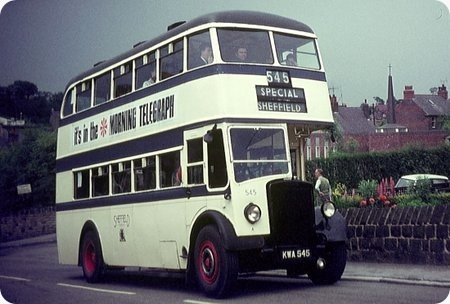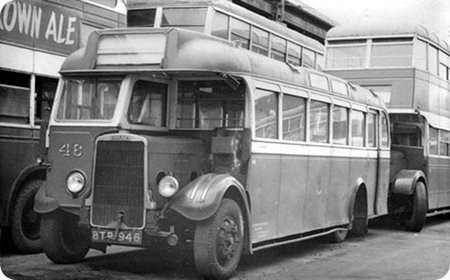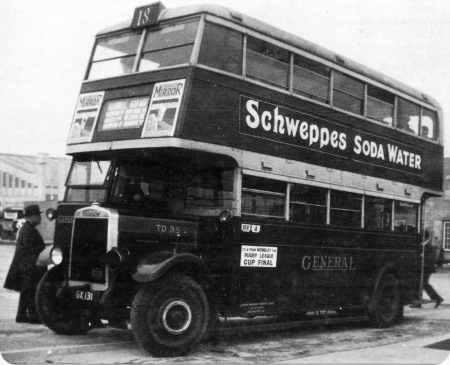Sheffield Corporation – Leyland Titan PD2 – KWA 545 – 545
Sheffield Corporation
1947
Leyland Titan PD2/1
Leyland H30/26R
This is an all Leyland (H30/26R) PD2/1 of the first batch of 20 delivered to Sheffield in October 1947. These were withdrawn between 1963 and 1965 but then nine of them were reinstated and lasted until 1966. In May 1966 The Leeds and District Transport News came to Sheffield in Leeds 380, another PD2/1 with an early Farington style Leyland body and the two buses were used on a tour of Sheffield routes. I joined the tour in Sheffield and I still remember how the Sheffield bus left the Leeds vehicle standing on some of the Sheffield hills that were encountered. I always had a soft spot for these reinstated buses and 545 looks a fine sight at nearly 19 years old climbing Greystones Road on the South Western side of the City. In Sheffield in those days 18/19 year old buses were something of a rarity. The bus looks to have been ‘bulled up’ by the Leadmill Road Depot for the occasion but still reflects the high standard maintained by Sheffield City Transport.
A full list of Titan codes can be seen here.
Photograph and Copy contributed by Ian Wild
———
Yes, Ian, they were long lived – 13 being the average age before withdrawal of STD buses. These were exceptionally long lived – even more so those which had a second life as driver trainers in all over blue. [But do I remember trainers being grey before that?]
I never rode "in service" on these but did the swimming run from Greenhill to Heeley Baths and games run from King Edward’s at Broomhill to either Trap Lane (Bents Green) or Castle Dyke (Ringinglow).
Superb picture by the way.
David Oldfield
———
NNW 380 became number 13 in the LCT Driving School, and when I applied for a job as a "direct" driver I took my test in it – at 5.00 pm in the Leeds City Centre rush hour. It behaved like a dream and after a couple of miles, at Tommy Wass in Dewsbury Road, the Senior Instructor said "Yes OK, straight back to Swinegate then." I was enjoying the vehicle very much and said so – Mr. Albert Bradley, a gentleman if ever there was one, said "Oh, OK then – carry on round the Ring Road and through Belle Isle and Hunslet first." It comes as no surprise to me that the Sheffield vehicle did better on the hills. I am not an engineer but it was common knowledge that LCT engines were "cut down" to save fuel. I’m sure this was a much misguided policy, as it undoubtedly resulted in ferocious, wicked and expensive vehicle abuse from a goodly proportion of disinterested drivers who were never brought to book – drivers who would boast of "being a fast man" and "I never come off late" etc etc – a reprehensible attitude, and one which allowed (and still does) operators to impose totally impossible and arguably illegal running times. I mustn’t get carried away with this latter subject because I could write a book with graphic illustrations of the scandal.
Chris Youhill
———
Thanks for the comment David.
The only one of the 1947 PD2s that was a driver trainer in mainly blue livery with two cream bands was D2 KWA 552 although it was later repainted in standard cream and blue. (I have photos of it in both schemes). The others were turned out in the standard cream/blue livery from the outset of their spell as trainers The trainers used prior to these were the 1948 Crossley/Northern Coachbuilders deckers which were certainly in mainly blue colours.
I can recall earlier trainers in grey – wonder if this was something to do with the wartime colours? I have a photo of ex 474 HWA 384 which looks to be all over one colour (grey?) and also one of ex 340 EWA 540 which is in a dark colour with cream window surrounds. Other than these I don’t have any evidence of grey liveried trainers. Does this help?
Ian Wild
———
Did remember the Crossley/NCBs but also wondered whether the grey had anything to do with using up war-time paint stocks. Thanks Ian.
David Oldfield
Quick links to the - Comments Page - Contact Page - Home Page



